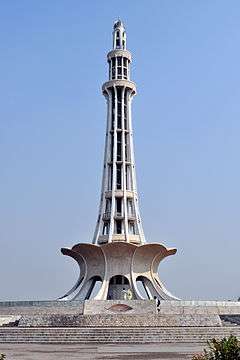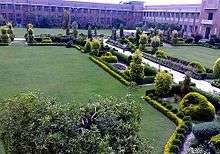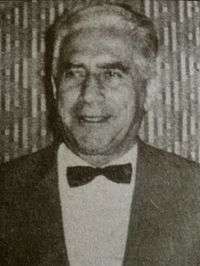Nasreddin Murat-Khan
| Nasreddin Murat-Khan TI | |
|---|---|
|
Murat-Khan in 1962 | |
| Native name |
|
| Born |
1904 Dagestan, Russian Empire |
| Died |
15 October 1970 (aged 65–66) Lahore, Punjab, Pakistan |
| Cause of death | Heart attack |
| Resting place |
New Elahi Park, Misri Shah Cemetery, Lahore 31°35′9″N 74°19′58″E / 31.58583°N 74.33278°E |
| Nationality |
Russian (1907–1950) Pakistani (1950–1970) |
| Education |
Civil engineering Architecture |
| Notable work |
Minar-i Pakistan Gaddafi Stadium |
| Home town | Dagestan |
| Spouse(s) | Hamida Akmut (m. 1944–70) |
| Children | Pari Murat-Khan, Zeynab Ozbek, Maryam Murat-Khan, Mesme Tomason, Meral Murat-Khan (daughters) |
| Awards |
(1963) |
Nasreddin Murat-Khan[lower-alpha 1] TI (1904–1970) was a Russian-born Pakistani architect and civil engineer. He is remembered most for designing the national monument, the Minar-i Pakistan.[1][2][3] He was also the architect of the Gadaffi Stadium in Lahore and several other notable buildings and structures.
Life
Early life
Murat-Khan was born in 1904 to a Turkic Muslim family, in the North Caucasus region of Dagestan located in the Russian Empire (later part of the Soviet Union, and now the Russian Federation).[4][5] In 1930, he obtained his degree of civil engineering from the Institute of Architects, Town Planners and Civil Engineers at Leningrad State University (now the Saint-Petersburg State University).[6][7] Later, he also obtained degrees of architecture and town planning from the same university.[8]
Exile
Murat-Khan was keen to free the Muslim Caucasus region from Soviet control.[9] As a result, he had to flee from Dagestan—for the fear of his life—to Germany where he landed sometime in 1944.[10] He stayed as a refugee in one of the camps established by the UNRRA in Berlin, later moving to Mittenwald where[11] he married Hamida Akmut, a Turkish refugee, in 1946.[12]
Pakistan
After the six-year-long exile in West Germany, Murat-Khan migrated with his family to Pakistan, in 1950.[13]
Death
Murat-Khan died of a heart attack on 15 October 1970.[14][15]
Professional career
In 1930, Nasreddin held a variety of posts in Dagestan and in Leningrad.[16] He was arrested during the "Engineers' Purges" undertaken by Stalin, but was re-instated in February 1940 as Chief Engineer and Chief Architect of the Pyatigorsk branch of the North Caucasian Project Trust.[17] He later served as Chief Engineer and Director of the North Caucasian Project Trust in Woroschilowsk, Ukraine, till August 1942.[18] Murat-Khan planned and designed many buildings of the Soviet Union, which includes a Lenin Memorial.[19] In 1950, after his migration to Pakistan, he was hired as Executive Engineer for PWD at Wah Ordinance Factory. He then was reassigned in 1951 as Special Architect, B&R Deptt., PWD, where he designed the buildings of the Nishtar Hospital and the Nishtar Medical College.[20] In addition, he also prepared the designs of the Mansehra Mental Hospital, the Sahala Police Training College, the Sinclair Hall in Forman Christian College,[21][22] the Gaddafi Stadium in Lahore (completed in 1959 and initially called the Lahore Stadium) and the Textile College, Faisalabad among many other buildings, townships, residences and other structures.[23]
Minar-i Pakistan

Murat-Khan's most notable and memorable work is his design of the Minar-i Pakistan monument, located at Minto Park (now Iqbal Park) in the walled city of Lahore.[24][25] The foundation stone of Minar-i Pakistan was laid at Minto Park on 23 March 1960. In 1963, President Ayub Khan reportedly summoned Murat-Khan to his office and took out a fountain pen from his pocket, placed it upright on his desk and instructed Murat-Khan to "build me a monument like this."[26]
Murat-Khan was very keen on the supervision of the construction and the design.[27][28] He frequently visited the site to inspect building material, construction quality.[29] He did not take his prescribed fee of Rs. 250,000 and instead donated the amount to the fund created for financing the construction of the Minar-i Pakistan.[30] The construction of the tower took eight years and by 31 October 1968, the minar was completed at a cost of Rs. 7.5 million.[31][32]
Awards
In recognition of Murat-Khan's services, the then President of Pakistan, General Ayub Khan, conferred on him the Tamghah-yi Imtiyaz (Medal of Excellence) in 1963.[33][34][35]
Views and legacy
Murat-Khan was of the view that each local body should have a chief architect of its own.[36] He was also a proponent of Islamic architecture, advocating the retention of a national character in Pakistani architecture.[37]
Gallery
- Murat-Khan's architectural contributions
 Minar-i Pakistan at night
Minar-i Pakistan at night Sinclair Hall in Forman Christian College, Lahore
Sinclair Hall in Forman Christian College, Lahore.jpg) Gaddafi Stadium, Lahore
Gaddafi Stadium, Lahore Buildings of Nishtar Medical College, Multan
Buildings of Nishtar Medical College, Multan
See also
Footnotes
- ↑ Ottoman Turkish: نصر الدین مراد خان ِALA-LC: Naṣru l-dîn Murâd-ḫân; Turkish: Nasreddin Murat-han IPA: [nasredˈdin muˈɾat-han]; Russian: Насреддин Муратханов ALA-LC: Nasreddin Muratkhanov IPA: [nəsrʲɪˈdʲin mʊrɐtˈxanəf]; Urdu: نصر الدین مرات خان ِALA-LC: Naṣru l-dīn Murāt Ḵẖān IPA: [nəsrʊd̪ˈd̪iːn mʊˈrɑːt̪ xɑːn]
References
- ↑ Jafari 2010
- ↑ Dawn 2009
- ↑ Nai Baat 2013
- ↑ Jafari 2010
- ↑ Nai Baat 2013
- ↑ Biography 1970
- ↑ Dawn 2009
- ↑ Jafari 2010
- ↑ Dawn 2009
- ↑ Jafari 2010
- ↑ Dawn 2009
- ↑ Jafari 2010
- ↑ Jafari 2010
- ↑ Jafari 2010
- ↑ Dawn 2009
- ↑ Dawn 2009
- ↑ Dawn 2009
- ↑ Dawn 2009
- ↑ Jafari 2010
- ↑ Jafari 2010
- ↑ F.C. College 2014
- ↑ The Nation 2014
- ↑ Jafari 2010
- ↑ Jafari 2010
- ↑ Samiuddin 2014
- ↑ Express Tribune 2014
- ↑ Jafari 2010
- ↑ Dawn 2009
- ↑ Dawn 2009
- ↑ Jafari 2010
- ↑ Express Tribune 2014
- ↑ The Friday Times 2015
- ↑ Biography 1970
- ↑ Jafari 2010
- ↑ Dawn 2009
- ↑ Artasia 1965
- ↑ Biography 1970
Bibliography
- Artasia (1965), Artasia, AICA Regional Secretariat for South Asia and the Far East, pp. 30–31, retrieved 13 January 2014,
Mr. Nasreddin Murat Khan wondered why there were no chief architects or separate architects for corporations and major municipal committees. He had been moving around in many parts of the world and could state from personal knowledge that architects did exist in other countries for such local bodies He was of the view that the government should immediately take note of this necessity and arrange the creation of these posts in the corporations and at least in the principal municipalities... Mr. Nasreddin Murat Khan emphasised the retention of a national character in our architecture and said that we were a Muslim community stretching from north-west Africa to the Far East. It should be possible to achieve a certain uniformity of approach towards well-defined features of Muslim architecture as such, even though some of these features may no longer be necessary or relevant, and could be dispensed with.
- Biographical Encyclopedia of Pakistan (1970), Biographical Encyclopedia of Pakistan, Biographical Research Institute, Pakistan, for International Publishers (Pakistan), p. 703, retrieved 13 January 2014,
Nasreddin Murat Khan, T.I. ; graduated from the Institute of Architects-Town Planners and Civil Engineers, University of Leningrad (U. S. S. R.) 193fj; is holding degrees in Architecture-Town Planning and in Civil Engineering ; was awarded Tamgha-i-Imtiaz by the President ENGINEERING & ARCHITECTURE (PART II) 703.
- DAWN (22 March 2009), Remembrance: The man behind the masterpiece, retrieved 6 January 2014
- Express Tribune (14 August 2014), Flashback: The forgotten architect, retrieved 14 August 2014
- Saud, Saad (13 June 2015), "Four noted personalities who adopted Pakistan as their motherland", The Express Tribune, retrieved 14 June 2015
- F.C. College (30 January 2014), January 150 Quiz Answers, retrieved 14 February 2014
- The Nation (10 June 2014), FC College gets a postage stamp, retrieved 20 May 2015
- The Friday Times (27 March 2015), The making of Minar-e-Pakistan, Lahore (circa 1965), retrieved 20 May 2015
- Jafari, Aqeel Abbas (2010), Pakistan Chronicle (in Urdu) (1st ed.), 94/1, 26th St., Ph. 6, D.H.A., Karachi: Virsa Publications, pp. 171, 198, 216, 225, 273, 320, ISBN 9789699454004
- Nai Baat (2013), عمران خان دھوکا نہ دینا۔۔۔, retrieved 12 January 2014
- Samiuddin, Osman (15 November 2014), The Unquiet Ones: A History of Pakistan Cricket, HarperCollins Publishers India, ISBN 9789350298022, retrieved 20 May 2015,
The main attraction of the park now, the Minar-e-Pakistan, commemorates that resolution... It was completed in 1968, a result mostly of the efforts of Nasreddin Murat Khan, a Pakistani of Russian descent who had been part of one of Stalin's many purges.
